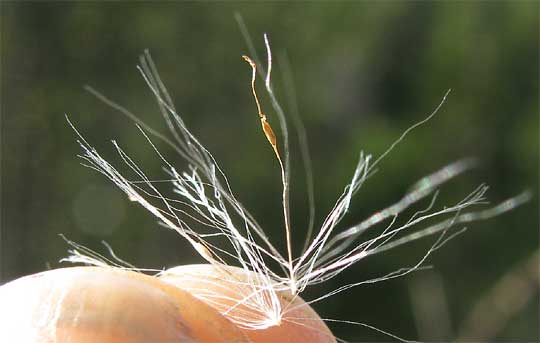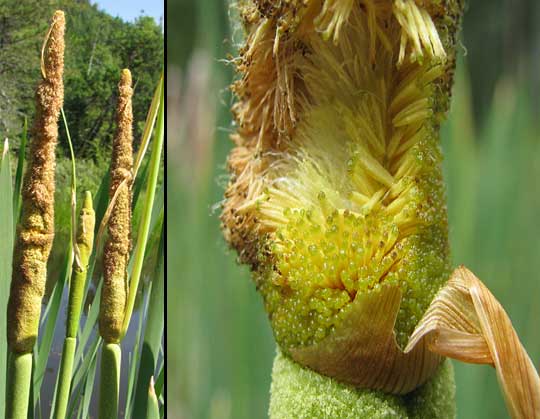Excerpts from Jim Conrad's
Naturalist Newsletter

from the the April 19, 2009 Newsletter, issued from the Siskiyou Mountains west of Grants Pass, Oregon:
CATTAILS IN THE SNOW
About a minute upslope from my trailer there's a wonderful little pond I'll be writing a lot about, and cattails grow along its banks. Last Tuesday morning it began snowing and the thing I wanted most to do was to go see how those cattails looked in the snow. The resulting picture is shown above.
You can see that above every brown cattail head there's a slender, pointed stem several inches long projecting upward. Last summer that slender finger bore hundreds of tiny, closely packed male flowers, while just below that male part closely packed female flowers covered the stem. Now wasted male flowers constitute a black, matted shag covering the spike top, while down below the thicker, brown zone earlier populated with female flowers now consists of an enormous number of cattail fruits, each fruit attached to its own "parachute" of fuzz, like a Dandelion "seed." You can see a single fruit with its fuzz below:

The cattail fruit is that tiny, brown swelling on the upright stalk in the picture's center. You can see that a white bristle continues upward from atop the fruit. Back in flowering days when the fruit was an ovary, that white bristle atop the fruit was the style and at its very tip was the stigma, the female part on which pollen grains germinate.
On dry, breezy days, what a pleasure to sit amidst the cattails. Maybe a finch comes pecking and tugging at the brown spike, and at this season every fruit with its fuzz inside the spike is more than eager to be released from its confinement among thousands of other fruits. With the merest scrape of your thumb across the spike's brown, velvety surface, grand, tickling fluff-clouds explode into the wind and if it's sunny you see them blowing across the pond like burning embers, maybe wafting into the big pines, prepared to find a new home beside a pond far, far away.
In the picture, that's the Common Cattail, TYPHA LATIFOLIA. Three cattail species are listed for California. The Common is found throughout North America and Eurasia, except for the most northern extremities.
from the June 14, 2009 Newsletter, issued from the Siskiyou Mountains west of Grants Pass, Oregon:
CATTAILS FLOWERING
Nowadays the cattails' handsome, brown fruiting heads are bleached gray and mostly fallen over, only a few still issuing parachuted fruits into the wind. However, the plants' submerged rootstocks have sprouted a luxuriant crowd of new green blades, and from many tufts of new blades arise this season's flowering heads -- the brown fruiting heads of the future.

Above at the photograph's left you see some flowering heads at their current stage. Note that the spikes in that picture at the left have upper, yellow-brown, irregular-surfaced parts and lower, green, smooth- surfaced parts, separated by narrow constrictions.
Cattail flowers are unisexual. The yellow-brown parts above the constrictions are composed of male flowers while the greener parts of the spikes below the constrictions bear female flowers. On the picture's right you see the constriction close-up, male flowers above (some removed so you can see male flowers from the side), and below the constriction you see the tops of close-packed female flowers.
Where the male-flower area is browner and rougher, the flowers are more mature and already releasing pollen. The lower, smoother part of the male-flower zone holds male flowers not yet producing pollen. Just before flowers in the male spikes begin producing pollen -- while they're still in the smooth-surface stage -- you can eat male flowers off the stalk like corn on the cob. It isn't very tasty but it's OK if you're hungry, and probably nutritional, since you're eating a lot of pollen. You can soak such male spikes in butter and fry them, but it tastes like cotton soaked in hot butter so there's not much use doing it unless you don't have anything else, and if you have butter in the first place, probably you do.